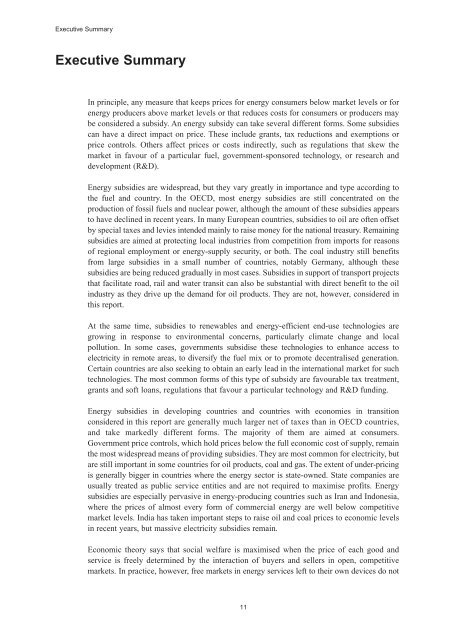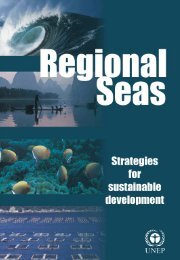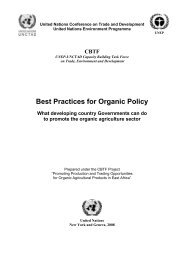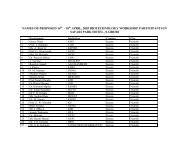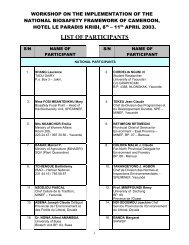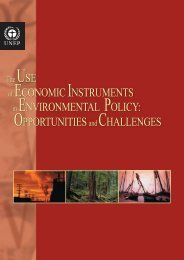Energy Subsidies: Lessons Learned in Assessing their Impact - UNEP
Energy Subsidies: Lessons Learned in Assessing their Impact - UNEP
Energy Subsidies: Lessons Learned in Assessing their Impact - UNEP
Create successful ePaper yourself
Turn your PDF publications into a flip-book with our unique Google optimized e-Paper software.
Executive Summary<br />
Executive Summary<br />
In pr<strong>in</strong>ciple, any measure that keeps prices for energy consumers below market levels or for<br />
energy producers above market levels or that reduces costs for consumers or producers may<br />
be considered a subsidy. An energy subsidy can take several different forms. Some subsidies<br />
can have a direct impact on price. These <strong>in</strong>clude grants, tax reductions and exemptions or<br />
price controls. Others affect prices or costs <strong>in</strong>directly, such as regulations that skew the<br />
market <strong>in</strong> favour of a particular fuel, government-sponsored technology, or research and<br />
development (R&D).<br />
<strong>Energy</strong> subsidies are widespread, but they vary greatly <strong>in</strong> importance and type accord<strong>in</strong>g to<br />
the fuel and country. In the OECD, most energy subsidies are still concentrated on the<br />
production of fossil fuels and nuclear power, although the amount of these subsidies appears<br />
to have decl<strong>in</strong>ed <strong>in</strong> recent years. In many European countries, subsidies to oil are often offset<br />
by special taxes and levies <strong>in</strong>tended ma<strong>in</strong>ly to raise money for the national treasury. Rema<strong>in</strong><strong>in</strong>g<br />
subsidies are aimed at protect<strong>in</strong>g local <strong>in</strong>dustries from competition from imports for reasons<br />
of regional employment or energy-supply security, or both. The coal <strong>in</strong>dustry still benefits<br />
from large subsidies <strong>in</strong> a small number of countries, notably Germany, although these<br />
subsidies are be<strong>in</strong>g reduced gradually <strong>in</strong> most cases. <strong>Subsidies</strong> <strong>in</strong> support of transport projects<br />
that facilitate road, rail and water transit can also be substantial with direct benefit to the oil<br />
<strong>in</strong>dustry as they drive up the demand for oil products. They are not, however, considered <strong>in</strong><br />
this report.<br />
At the same time, subsidies to renewables and energy-efficient end-use technologies are<br />
grow<strong>in</strong>g <strong>in</strong> response to environmental concerns, particularly climate change and local<br />
pollution. In some cases, governments subsidise these technologies to enhance access to<br />
electricity <strong>in</strong> remote areas, to diversify the fuel mix or to promote decentralised generation.<br />
Certa<strong>in</strong> countries are also seek<strong>in</strong>g to obta<strong>in</strong> an early lead <strong>in</strong> the <strong>in</strong>ternational market for such<br />
technologies. The most common forms of this type of subsidy are favourable tax treatment,<br />
grants and soft loans, regulations that favour a particular technology and R&D fund<strong>in</strong>g.<br />
<strong>Energy</strong> subsidies <strong>in</strong> develop<strong>in</strong>g countries and countries with economies <strong>in</strong> transition<br />
considered <strong>in</strong> this report are generally much larger net of taxes than <strong>in</strong> OECD countries,<br />
and take markedly different forms. The majority of them are aimed at consumers.<br />
Government price controls, which hold prices below the full economic cost of supply, rema<strong>in</strong><br />
the most widespread means of provid<strong>in</strong>g subsidies. They are most common for electricity, but<br />
are still important <strong>in</strong> some countries for oil products, coal and gas. The extent of under-pric<strong>in</strong>g<br />
is generally bigger <strong>in</strong> countries where the energy sector is state-owned. State companies are<br />
usually treated as public service entities and are not required to maximise profits. <strong>Energy</strong><br />
subsidies are especially pervasive <strong>in</strong> energy-produc<strong>in</strong>g countries such as Iran and Indonesia,<br />
where the prices of almost every form of commercial energy are well below competitive<br />
market levels. India has taken important steps to raise oil and coal prices to economic levels<br />
<strong>in</strong> recent years, but massive electricity subsidies rema<strong>in</strong>.<br />
Economic theory says that social welfare is maximised when the price of each good and<br />
service is freely determ<strong>in</strong>ed by the <strong>in</strong>teraction of buyers and sellers <strong>in</strong> open, competitive<br />
markets. In practice, however, free markets <strong>in</strong> energy services left to <strong>their</strong> own devices do not<br />
11


